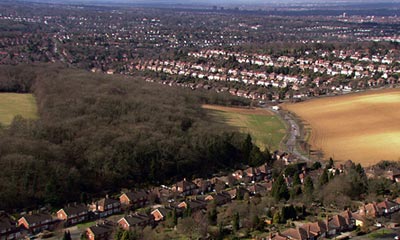Massive housing schemes threaten green belt
MORE than a quarter of a million new homes are being planned for Yorkshire over the next 15 years, threatening swathes of the region's Green Belt.
A massive building scheme of 273,800 homes is claimed to be needed to cope with a rise in population that would follow a predicted economic boom, according to strategic plans being drawn up by the region's unelected regional assembly.

But the plan has outraged countryside campaigners, who say that the home building figure is far too high and will see too much unspoilt land disappearing under bricks and concrete.
In some parts of rural Yorkshire, like Ryedale and the East Riding, the plan expects at least 60 per cent of new homes will be built on greenfield land.
But one council leader suggested that was an optimistic target and that proportion of pristine land being used would be much higher.
Critics also claim the overall home building target is not only based on uncertain forecasts but on the assumption that every English region is looking forward to growth over the next decade-and-a-half.
The building target is set out in the Yorkshire and Humber Assembly's new draft regional spatial strategy, a document commissioned by Whitehall which is intended to guide the development of the economy, transport network, housing, and the built and natural environment up to 2012.
It is crucial blueprint for the way Yorkshire will be shaped and is now out to public consultation until March. It will be the subject of scrutiny by a public inquiry in the autumn before it is considered by Ministers for approval.
Under the plan, West Yorkshire will need 121,350 new homes, South Yorkshire 54,100, North Yorkshire 42,250, and Humberside 45,050.
Affordable housing and the reuse of derelict neighbourhoods are uppermost in the strategy.
The overall housing need prediction was the result of work by consultants from Deloittes and Nathaniel Lichfield on expected regional economic success, the document stated, but it admitted that its forecasts might turn out to be wrong.
"It will take time for economic and regeneration measures to deliver the higher levels of migration envisaged, and there is still a risk that this change may not materialise as all the surrounding regions are pursuing growth agendas," it stated.
The plan features an average regional target of 65 per cent of new homes being built on brownfield land with individual targets for each local authority, based on expected availability ranging from 40 per cent in Ryedale to 90 per cent in Sheffield.
It also states that "strategic restraint" will be shown with regard to rural areas.
But the Campaign for the Protection of Rural England (CPRE) insisted last night that even though the brownfield use target is five per cent higher than Government targets that figure is still too low, and the overall target of 273,800 new homes is too high.
CPRE Yorkshire policy officer Jenny Hayes said: "The overall thrust of these figures is very alarming and seem to be driven by economic aspirations rather than realities. It's based on the belief that every region in England is going to keep on growing, but unless there's going to be a massive influx of people from abroad that is simply not going to happen everywhere.
"The brownfield use target is just too low and there needs to be more scope for reusing sites and buildings."
But North Yorkshire County Council leader John Weighell, who sits on the Yorkshire and Humber Assembly by virtue of being a council chief, welcomed the housing plan, stressing that the area was crying out for more homes to combat rocketing prices and prevent local people being priced out of the housing market.
"We don't want urban sprawl across North Yorkshire but restricting house building too much will damage the economy and do nothing to help local people," he said.
"As for using brownfield land, we would love to, but North Yorkshire doesn't have any, so we've very little choice. "
A copy of the draft plan is available on www.yha.gov.uk.
The numbers
New homes needed under the plan:
- West Yorkshire 121,350
- South Yorkshire 54,100
- North Yorkshire 42,250
- Humberside 45,050
yorkshiretoday.co.uk, 04.02.2006
